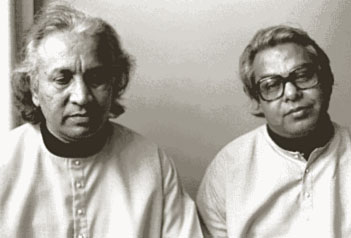 Dhrupad of Dagara Bani has been famously sung by the younger Dagar Brothers- Messrs Nasir Zahiruddin Dagar and Nasir Faiyas ud din Dagar. This Dhrupad is in Raaga Jayjayavanti and the Tala is Chautala. Raaga Jayjayavanti is held to be a very romantic Raaga and is best suited for night-time. This Raaga, in common with Raaga Bagesvari and Raaga Desa, belongs to the Khamaja Thata.
Dhrupad of Dagara Bani has been famously sung by the younger Dagar Brothers- Messrs Nasir Zahiruddin Dagar and Nasir Faiyas ud din Dagar. This Dhrupad is in Raaga Jayjayavanti and the Tala is Chautala. Raaga Jayjayavanti is held to be a very romantic Raaga and is best suited for night-time. This Raaga, in common with Raaga Bagesvari and Raaga Desa, belongs to the Khamaja Thata.
In this particular Dagara Bani the Dhrupad singers begin their performance with an Alaap which lasts for a total period of about twenty minutes and is rendered in three different Layas (tempo). The Alaap begins in Vilambita Laya (slow tempo). During the Alaap the singers unfold the form of the Raaga in a gradual manner and manifest the notes of the Raaga one by one. During the first eleven minutes the singers keep their singing restricted to Purvanga (the lower register and the lower part of middle register) but after this period they now shift their singing to the high register and go up to Tara ma (high F). This they keep up for three minutes after which the Laya of Alaap is doubled. The Alaap in this Laya is continued for approximately three minutes. The last phase of this Alaap is marked by a change in the tempo once again. This tempo is the double of the previous one and thus four times faster than the first one or the Vilambita Laya. The Alaap in this Druta Laya lasts for a period of about three minutes. Before ending the Alaap the singers come down from upper register to lower register and as they do it they return to the Vilambita Laya.
As soon as the Alaap ends, there is a complete lull. Even the drone of the Tambura comes to an end. This complete silence has a dramatizing effect. The silence lasts for a few seconds and then the drone of the Tambura starts again and the singers now begin the singing of the composition of the Dhrupad, piece by piece. The singers steady their voice on madhya sa (middle C) for a while and then sing the first Avarta of Sthayi twice. Each time they commence with madhya sa (middle C) which is followed by madhya re (middle D) with a touch of madhya ga (middle E). These notes are sung in one Matra with Minda. The singers swing from madhya re (middle D) to madhya ga (middle E) for sometime and only then ascend to madhya pa (middle G) with Minda. This has a very appealing effect.
Towards the end of the first Avarta they sing madhya ma (middle F) and mandra ni (low B) with minda. After singing the first Avarta of Sthayi twice the singers now take up the Sthayi as a whole. The tonal range of Sthayi is from mandra ma (low F) to madhya pa (middle G). After singing the whole Sthayi they once again sing the first Avarta of Sthayi in the same manner as before. They now sing Antara, Sanchari and Abhoga in one sequence. These are sung in Thaha. The Antara is sung in uttaranga (upper half of the tonal range). The tonal range of Antara is from mandra dha (low A) to tara ga (high E). It ends with mandra ni (low B). In the second Avarta of Antara they sing madhya dha (middle A) and tara re (high D) with minda. This is particularly appealing.
As soon as the Antara is finished, the Sanchari is commenced with a long minda from mandra pa to madhya ni. The tonal range of Sanchari is from mandra pa (low G) to madhya ni. After Sanchari they sing the first Avarta of Abhoga thrice. All the three times the melody of this Avarta remains unchanged and is the same as that of the first Avarta of Antara. After singing this they now sing the whole Abhoga once. After Abhoga the singer again sings the first Avarta of Sthayi twice in the same melody as before. After this they sing the Bolas (the words) of this Avarta in a variety of ways. Each time they deploy a different set of notes to demonstrate the aesthetic effect of changing melodies. And each time they also bring out minor variations in the phrase or phrases picked up for rendering. This is called Bolabanta. During Bolabanta the singers embellish their singing in a variety of ways.
After demonstrating Bolabanta in the first Avarta of Sthayi, they now take up the first Avarta of Antara for demonstrating the same. At first they sing the first Avarta of Antara in Thaha and then they demonstrate the Bolabanta in Chauguna. The Bolabanta of Antara is sung in uttaranga. Thereafter the singers sing the whole of Antara in Thaha in the same melody as before. They conclude the performance by singing in middle register the characteristic combination of notes of Raaga Jayajayavanti.




















